Reflections on the Bay
Reflections on Chesapeake Bay Restoration from the first Earth Day
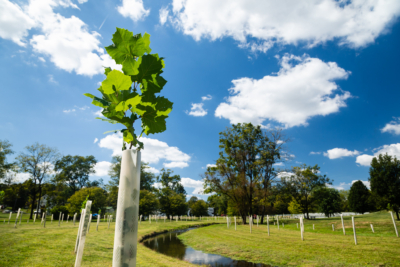
(Photo by Will Parson/Chesapeake Bay Program)
51 years after the first Earth Day, Chesapeake Research Consortium (CRC) asked our community and member institutions to reflect on decades of Chesapeake Bay preservation and restoration efforts to highlight how far we’ve come, accomplishments to be lauded, and challenges still to come in the future.
The April CRC Roundtable webinar that took place last month, Chesapeake Waters and Their Caretakers: Three stories from three perspectives, reflected on decades of Chesapeake Bay restoration efforts informed by the journeys of three panelists with multidimensional experiences in various components of the Bay health effort, including the Chesapeake Bay Program, research, and activism. Recordings of this and all of our webinars can be found on the CRC Roundtable YouTube channel.
How’d we get here?
By 1970, scientists understood that poor water quality was harming the Chesapeake Bay and its fisheries. “Leading up to that first Earth Day, there was an exponential increase in the use of nitrogen fertilizers in the watershed, and also the population growth in the watershed, along with increasing sewage discharges and air pollution,” said Tom Jordan, Senior Scientist at the Smithsonian Environmental Research Center (SERC).
Chesapeake Research Consortium formed two years after that first Earth Day, in January 1972, and has played a key role in coordinating the research institutions, scientists, and tools addressing these issues around the Chesapeake Bay ever since. Even though the Bay had already been the subject of considerable scientific research, pollution sources and their role in water quality and the surrounding environment were not yet well understood.
Hurricane Agnes hit the Bay during the summer of 1972, while Americans were focused on the news of five burglars breaking into the Democratic National Headquarters in the Watergate building. Both events ended up having very long term repercussions. As Jordan continues,
“You had Hurricane Agnes in 1972, just a couple years after the first Earth Day, and at that point, the Bay was really a mess.”
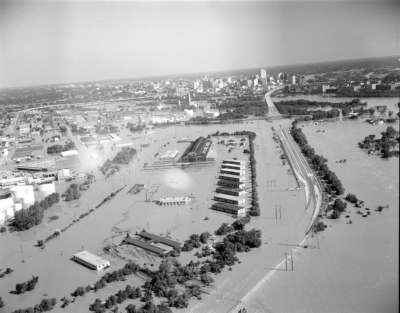
The I-95 bridge leading into Downtown Richmond partially submerged in flood water two days following Hurricane Agnes in 1972 (No. 72-1056, Virginia Governor’s Negative Collection, Library of Virginia).
The storm hit at just the wrong time of year and he explained, “The overload of nutrients was causing algal blooms, expansion of hypoxic zones, fish kills, and widespread die-off of SAV, which had really gotten started in the late 60s, but after Hurricane Agnes, it was just really wrecked. So then, that’s the lead into the need for restoring the Bay.” Learn more about this storm through CRC’s scientific response to Hurricane Agnes to understand the impacts of the hurricane on the watershed.
What’ve we done so far?
Since our beginnings, science has resulted in a large number of accomplishments and progress in Chesapeake Bay restoration. Collective action between citizens, scientists, non-profits, and governments at every level has led to significantly improved water quality in many areas of the watershed.
The CRC has organized and managed several initiatives that help advance the science and tools needed to enable greater progress. One example is the coordination and management of the Chesapeake Bay Program’s (CBP) Scientific and Technical Advisory Committee (STAC). “Organizing and coordinating STAC is really one of the great, great things that CRC has done over the years,” highlighted Fred Dobbs, Chair of the CRC Board of Trustees and Chair of the Department of Ocean & Earth Sciences at Old Dominion University (ODU).
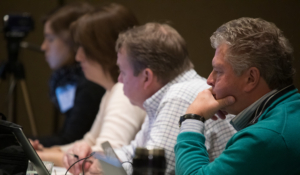
Members of the Science and Technical Advisory Committee at its quarterly meeting. (Photo by Will Parson/Chesapeake Bay Program)
Kevin Sellner, former CRC Executive Director and Retired Senior Scholar at the Center for Coastal & Watershed Studies at Hood College, explained that STAC is unique because the committee is both proactive and reactive to issues related to the Bay. “When the Bay Program, or its partners posed a question, they would come to us and we’d set up an independent review or a network of scientists with no agendas just to view the science and then weigh back in,” he detailed. “STAC was extremely important, in my mind, to make sure that the Bay Program adopted policies that embedded issues, like climate change, into the way that that policy would be implemented.”
In addition to coordinating STAC, the Chesapeake Community Modeling Program (CCMP), the Environmental Management Career Development Program (EMCDP), the Chesapeake Bay Expertise Database (CBED), and the Chesapeake Student Recruitment Early Advisement and Mentoring (C-StREAM) program, are other examples of how CRC aspires to fully enable its member institutions and the broader scientific community in the region to contribute effectively toward better understanding and management of the Chesapeake Bay and its watershed.
“There were bans on phosphorus use in some detergents and phosphorus removal from sewage treatment plants, and we saw dramatic improvements, especially in freshwater parts of the Bay, such as Gunston Cove on Patuxent River,” said Jordan. “There was also the development of biological nitrogen removal from sewage treatment plants, reducing the nitrogen inputs, and that’s been really important.”
Air pollution reduction due to Clean Air Act regulations and programs also resulted in significant decreases in air deposition of nitrogen. “Major accomplishments have been achieved in the reduction of nitrogen oxides and air pollution that has helped a lot in the reduction of nutrients coming into the Bay,” said Anson “Tuck” Hines, Director of SERC. Jordan echoed these sentiments, “Air pollution controls were put in place with catalytic converters on cars and trucks, smokestack scrubbers, and more, which have greatly reduced the nitrogen oxides released into the atmosphere and that’s reduced the nitrogen deposition to the Bay and its watershed and reduced the acidity of rain which is harmful to stream biota.”
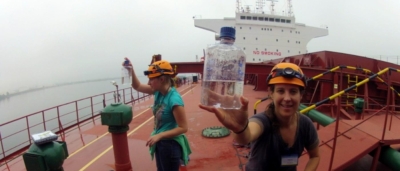
Researchers Kimberly Holzer and Catherine Carney collect plankton samples from a ballast tank to determine if ballast water management is reducing invasions risk. Photo by Kimberly Holzer
Another success story in the Chesapeake Bay is the management of invasive species. Invasive species in the Bay come from a variety of different vector sources, including intentional introduction, transport on ship hulls, and through ballast water. To address the ballast water vector, SERC has played an integral role in the development, maintenance, and operation of the USCG National Ballast Information Clearinghouse since its inception.
“We’ve been working actively for the past 30 years to change the behavior of shipping, to manage it and to track the national patterns of ballast water introductions and management. We work with the Coast Guard so every ship arriving at every port in the United States reports to SERC on their ballast water management practice and we provide those data both nationally to the Congress and to the Coast Guard, but also to every state to look at their own management practices,” Hines explained.
Even more recently, rapidly increasing technology has allowed ships to treat ballast water onboard. He further shared, “That’s a success story in many ways. Even though it took 30 years to move from first awareness to legislation, it’s actually causing a huge change in the behavior of international shipping, because it’s now gone from the United States with a few partners with countries like Canada, New Zealand, and Australia to the International Maritime Organization globally.”
Where we are going
The Chesapeake Bay watershed recovery path still faces several daunting challenges, all of which are compounded by climate change. Climate change has already begun to alter Bay species and ecosystems and will have a profound impact over the coming years.
Fred Dobbs highlighted two big challenges that should be prioritized, climate change and increasing underrepresented groups in Chesapeake Bay science, policy and regulatory agencies, “Everything goes back to climate change, it really, really does. That everything includes the biology, physics, chemistry, and geology of the Bay.”
“The inertia of climate change coming at us and the rate of change is accelerating very fast, and it’s so pervasively all-encompassing,” echoed Tuck Hines. “The ability to respond to that, even with the best intentions will require huge changes in how our economy and how our business is being carried on.”
Kevin Sellner highlighted the importance of acting at a local level to help communities fight climate change and build resilience to climate impacts. “There are something like over 100 communities across the US that have adopted climate recommendations and implemented them to reduce gas emissions and increase adaptations in their respective local areas.”
Looking forward to the future of the Chesapeake Bay includes increasing diversity, equity, inclusion, and justice (DEIJ) in all aspects of the program, from scientists to management and policy makers. “We’re asking questions about environmental justice and equity,” stated Tom Miller, Director of the Chesapeake Biological Laboratory at the University of Maryland Center for Environmental Science (UMCES). “Those are very, very complex questions and increasingly, those are the ones that I see being asked and those are the ones that will challenge us most.”
“All of the Chesapeake Research Consortium institutions including the Smithsonian, are heavily committed to the professional training of the next generation of scientists,” highlighted Hines. “I think we continue to do that better and well, although the issue of our ability to provide that training and resources to more equitable distribution of the citizens of the United States is an ongoing challenge.” CRC’s C-StREAM program, started by Bill Ball, former CRC Executive Director, is focused on recruiting, advising, and mentoring college students from populations who have been historically excluded from the environmental field and are underrepresented in environmental research and management professions. The program encourages and supports these students by working closely with academic institutions, as well as government agencies, within the Chesapeake Bay Program partnership to place students into meaningful summer internships, to support those students in their academic work, and to facilitate pathways for successful careers in environmental research, restoration, and/or management.
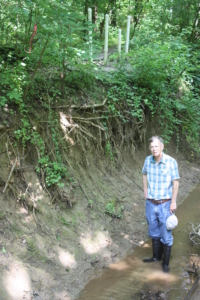
Tom Jordan standing in Muddy Creek, an eroded stream at SERC, before it was restored.
While progress has been made with nutrient reduction from wastewater pollution and air pollution reduction, there is still much to be done with nutrient pollution stemming from agriculture. “It’s been there from day one and incentivizing or regulating the agricultural community to tremendously reduce their load, not only here but everywhere, is critical,” said Sellner.
Research has shown us that a forested or well planted riparian buffer between cropland and water bodies greatly reduces nutrient pollution That led to the Bay-wide program of planting riparian buffers. “Agriculture has been pretty hard to manage but there has been some progress. With the use of cover crops, restoration of riparian buffers, restoration of wetlands, and the use of more precise fertilizer applications, that’s helping to improve the agricultural impacts,” explained Jordan. “All of this progress has been supported by a steady increase in knowledge about the sources and solutions for nutrient pollution.”
Another future challenge for the Chesapeake Bay is expansion of renewable energy and offshore wind farms. Jonathan van Senten, Assistant Professor & Extension Specialist at the Virginia Seafood Agricultural Research and Extension Center at Virginia Tech, shared that offshore wind permitting is going to be a hurdle and obstacle, but there are potential benefits to communities in the Chesapeake Bay and across the Atlantic coast, including economic benefits.
“I think for the Bay, in general, it presents a unique opportunity because when you look at what’s happened with Block Island [Rhode Island], and some of the other areas, you see that there is somewhat of a tourism component that develops around this,” he explained. “Overall, from an energy standpoint, it’s definitely a positive that we’re moving towards renewables. It’s up to us to make sure that we’re maximizing the positive benefits of having this here and how else we can do that beyond just the wind farm, like tourism, recreational fishing, or research. Let’s use this opportunity to get the most out of it, not just from an energy standpoint, but as a Commonwealth in general.”
Tomorrow, next week, next month, or next year, we’re sure to learn more about new and different challenges to the Chesapeake Bay and its watershed. We’re proud of CRC’s resiliency and collective strength in bringing the best science to bear on this international model for ecosystem restoration.
What we’ve seen is that there is perpetual interaction between research, legislation, corporate actions, and human behaviors. The importance of science and the committed engagement of scientists in the restoration effort cannot be over-emphasized, from just describing the problem and setting up the modeling and monitoring programs, to the continued research. “We need science going forward to help guide us in that restoration trajectory. Science has been part of the history, but it also has to be part of the future Chesapeake Bay restoration,” said Bill Dennison, Professor of Marine Science and Vice President for Science Applications at UMCES.
